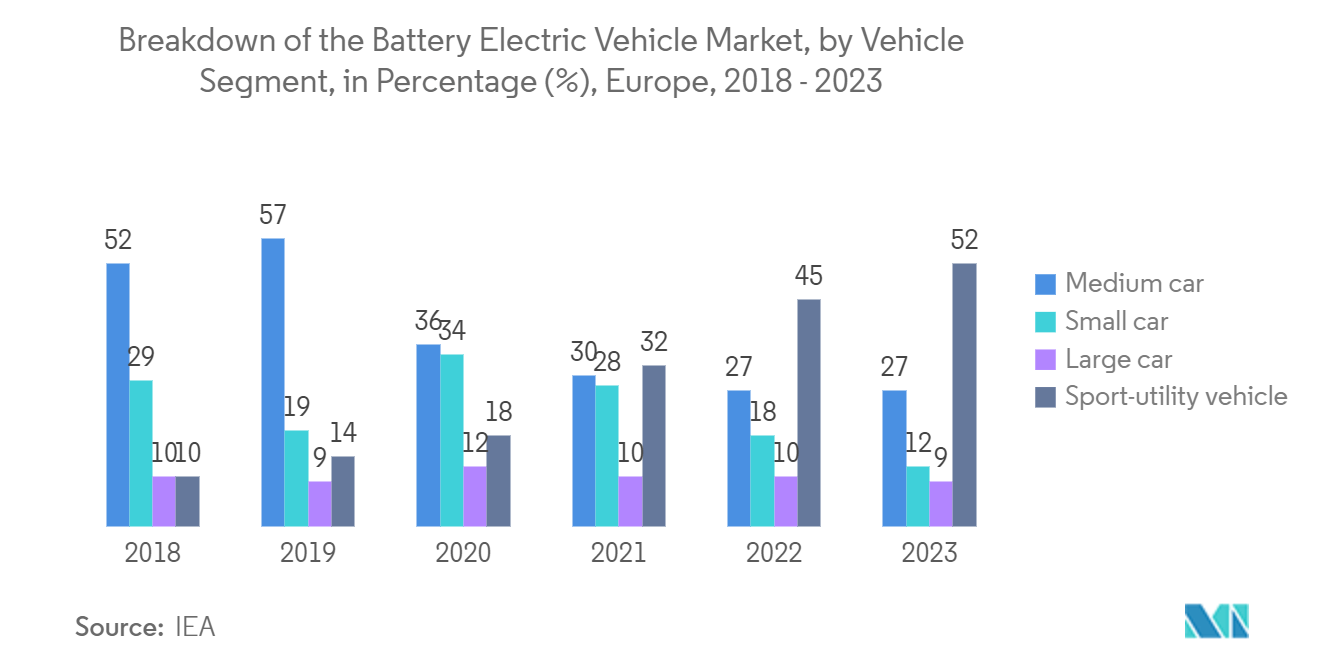Market Trends of Europe Logic Integrated Circuit (IC) Industry
Programmable Logic Device is to Drive the Market
- PLDs (Programmable Logic Devices) can be programmed to perform specific logic operations. They are frequently employed in digital systems to minimize the amount of logic necessary to carry out the desired function. PLDs come in two varieties: programmable array logic (PAL) and programmable logic arrays (PLA). The output signals from these devices can also be programmed to be in various formats, including digital, analog, PWM, or pulse-width modulation.
- PLDs are also more dependable than custom logic components because they can be tested and reprogrammed on the fly. Larger and more complex logic functions can be produced using PALs and programmable logic components. PLDs are employed in various systems, including digital signal processing, communications, digital control systems, embedded systems, automotive electronics, industrial automation, medical systems, and aerospace and military systems.
- The demand for programmable logic devices is also rising due to the rapid development of field programmable gate arrays (FPGAs). Digital signal processing, communications, and other uses that call for complex logic circuits frequently use gate arrays. The growth of the communications sector in the area is anticipated to increase demand for PLDs. For instance, the European Commission (EC) presented its vision for the digital transformation of Europe by 2030 in the framework of the Digital Decade in 2021. Such initiatives are anticipated to accelerate market expansion.
- Due to their internal architecture, PLDs and gate arrays provide high-speed performance by enabling direct connections between logic components. Gate arrays and programmable logic devices are widely used in robotics applications to control arms, legs, and other robotic parts. Robot adoption is expected to increase across several EU regions, providing several market opportunities for PLD manufacturers.
- According to IFR, around 384,000 industrial robots were shipped globally in 2020. European industrial robot installations were 79 thousand in 2023. It is projected that by 2024, industrial robot installations in Europe will reach 77,000 units. Such elements are anticipated to increase the demand for PLDs due to their widespread use in robots.
- Moreover, networking applications like routing and switching use programmable logic devices and gate arrays. The market is anticipated to be driven by 5G, a crucial new generation of network technology. By 2025, there will be 311 million 5G connections in Europe, according to GSMA. In this regard, the EU set ambitious goals for covering all populated areas in Europe with 5G and providing gigabit connections to every home by 2030. These elements are anticipated to propel networking applications, which propel the market in the region.
- Furthermore, programming logic devices and gate arrays have revolutionized the design and construction of electronic systems. Medical devices like pacemakers and defibrillators use programmable logic devices and gate arrays.

Automotive is Expected to Hold a Significant Share
- The market's growth is accelerated by the expansion of the use of logic semiconductors due to ongoing technological developments in the automotive sector and lower power consumption. The automotive industry's rapid growth and increased car sales due to more connectivity options in vehicles are helping the industry grow.
- The European automotive industry has become the leader in the global industry due to its numerous regional contributions, including those from Germany, the UK, and other nations. The EU's automotive industry is a worldwide leader owing to its efficient, high-quality vehicles. Government initiatives to promote zero-emission vehicles are anticipated to drive market expansion during the anticipated period due to the high uptake of EVs in the region. According to IEA, by 2023, SUVs made up over half of the BEV sales in Europe, while medium cars accounted for over a quarter of the market.
- According to VDA, 11.3 million new cars were registered on the European passenger car market in 2022, about 4% less than the previous year. Additionally, the demand for electric vehicles is growing in the area due to increasing consumer awareness of environmental pollution and rising oil prices, boosting the logic IC market.
- Moreover, according to EV Volumes data, more than 2.6 million new passenger plug-in electric cars will be registered in Europe in 2022. Accordingly, 413,483 new passenger plug-in cars were registered in Europe in December 2022 (up 46% compared to the previous year), accounting for 38% of the market. It is anticipated that this increase in EV sales is anticipated to encourage the installation of logic-based ICs designed to meet their needs in EVs.
- The German automotive industry has been at the forefront of technological advancements in the global automotive sector thanks to the incorporation of smart technology. For example, according to the KBA motor transport authority, the total number of fully electric vehicle sales in Germany increased by 44 percent to 57,980, representing a market share of 22.3%. Due to the Thishigh demand for electric vehicles, new-car registrations in Germany increased by 31% in November 2022. The need for Logic ICs is anticipated to increase as EV sales rise.
- Furthermore, programmable logic devices and gate arrays are used in automotive electronics, such as engine control and safety systems. In June 2022, the EU enacted the new Vehicle General Safety Regulation, which mandates various advanced driver assistance systems to improve road safety and establishes the legal framework for approving automated and fully driverless vehicles in the EU. Such government initiatives are anticipated to increase demand for Logic ICs in applications for vehicle safety systems.
- The transportation sector is among the most significant contributors to EU greenhouse gas emissions. To advance toward its 2050 goal of becoming climate neutral, the European Commission has announced a ban on selling all cars with combustion engines starting in 2035. These elements are anticipated to propel EV adoption in the EU region, which is expected to increase demand for Logic ICs in the sector.


